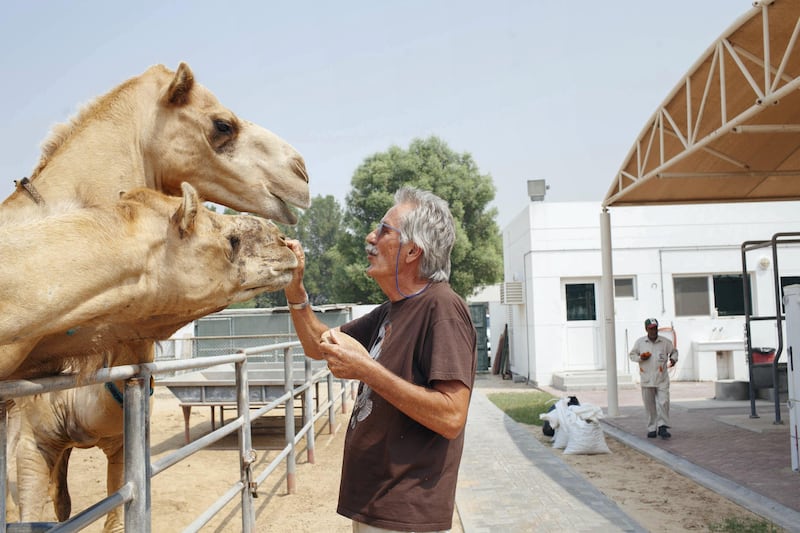No animals are more closely associated with this region than the falcon and the camel, which have played central roles in the lives of people around the Gulf for thousands of years.
And the present-day popularity of falconry, camel racing and camel farming shows that these creatures remain as important as ever in the modern era.
Given these animals’ cultural and economic significance — individual racing camels can sell for many millions of dirhams, for example — it is especially unfortunate when sickness strikes.
Among the most feared illnesses in camels is Camelpox, a viral condition that causes skin lesions and that can kill affected animals, especially if they are young.
Similarly, falcons can fall victim to Falconpox, which is caused by a type of avian pox virus. Like Camelpox, it can prove fatal, an especially devastating outcome if the falcon is a prized individual.
Just as falcons can become seriously ill from an avian pox virus, so can one of the creatures they hunt, the houbara, which is found wild in the UAE.
A bustard that falcons are often trained to catch, the houbara is vulnerable to the Houbarapox viral infection. It is another potential killer, with animals that suffer a secondary infection especially likely to die.
Although these viral infections are all potentially serious, there are vaccinations against each of them, and a centre in the UAE is at the cutting-edge of region-wide inoculation efforts.
The Central Veterinary Research Laboratory (CVRL) in Dubai is now producing, on a commercial scale, vaccines against Camelpox, Falconpox and Houbarapox, and these are being distributed around the Gulf and beyond, including to North Africa and East Africa.
The CVRL has also begun producing what is known as a hyperimmune serum — blood plasma containing large amounts of antibody — that can be used against a pathonogenic bacterium, Clostridium perfringens, that causes a fatal disease in a number of animal species.
Approval to supply the vaccines was given last year by the UAE authorities following a rigorous programme of development and certification lasting six years. This included approval from the Ministry of Climate Change and Environment and extensive testing of the vaccines by the Ministry of Health and Prevention.
Dr Ulrich Wernery, the CVRL’s scientific director, said that, previously, all veterinary vaccines used in the UAE were imported. Now, vaccines or hyperimmune serum can be produced against the particular strains of the viruses or bacteria that are found locally, meaning they are likely to be more effective.
“These are bacterial and viral strains which occur here. This is a big advantage for this vaccine. Sometimes vaccines were introduced from abroad, but they didn’t work because they’re different strains,” he said.
“We isolate the bacterium or virus from diseased or dead animals — from the lungs, from the kidneys, from the liver.”
The vaccines against the three types of pox are made from what is known as an attenuated form of the virus. The virus has been altered in the laboratory so that its pathogenicity — its ability to cause illness — has been removed, but the virus itself remains active.
When the animal is injected with the vaccine, it produces antibodies against it, offering protection in case it suffers an infection.
“We remove the pathogenic part in the bacterium or virus. It’s not pathogenic anymore, but it produces a solid immunity,” said Dr Wernery.
Because the attenuated virus is able to continue to reproduce inside its host, the recipient animal keeps on generating antibodies indefinitely. As a result, vaccines that contain attenuated viruses tend to confer lifelong immunity, in contrast to vaccines that contain inactivated viruses, for which annual vaccination may be needed.
Many vaccines given to people to prevent conditions ranging from smallpox to measles, mumps and rubella also contain attenuated virus.
While the three vaccines are aimed at stopping animals from falling victim to a viral infection, the role of the hyperimmune serum is to cure animals that have already become ill, in this case with a bacterial, rather than a viral, infection. The serum is administered directly into a vein so it can circulate in the animal’s bloodstream. Its positive effects often become apparent quickly.
“Animals that have suffered with the infection and were almost dead, they got this hyperimmune serum and half an hour later they get up and start to eat because the toxin is neutralised immediately,” said Renate Wernery, a virologist and PR manager at the CVRL, and Dr Wernery’s wife.
Set up in 1985 under the auspices of Sheikh Mohammed bin Rashid, Vice President and Ruler of Dubai, by director-general Dr Ali Ridha, the CVRL has grown in size from an initial staff of three people to 140 now. Among the key researchers involved in the vaccine production is Sunitha Joseph, who is completing her PhD at the University of Kent in the UK.
Mrs Wernery, who with her husband joined the CVRL in 1987, said their production of vaccines and hyperimmune serum had caused “quite a stir” among the local veterinary community, in a positive way.
“Never before has there been a veterinary vaccine produced in our region, and it’s run through all the necessary regulation and registration channels,” she said.
Research at the centre could help to safeguard the health of people as well as animals, as current research projects include one focused on Middle East Respiratory Syndrome (Mers). A key aim is to find out how to prevent transmission from camels to humans of the virus that causes Mers.
In another research programme, the CVRL is now looking to supply on a commercial basis are vaccines against animal viral illnesses in addition to the three for which it has already started production. Among the extra conditions it hopes to produce vaccines for is Sheeppox.
“For us, it’s important to have the right techniques, then we can go further and develop vaccines for other animal species,” said Dr Wernery.







